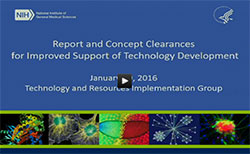At its September 2015 meeting, our Advisory Council endorsed a concept for funding existing NIGMS-supported synchrotron resources in which the technologies have become mature. This plan will align the funding mechanism used to support the beamlines with the goal of ensuring reliable access to these essential resources for structural biology.
In place of the variety of mechanisms we currently use, we intend to issue a funding opportunity announcement (FOA) called Mature Synchrotron Resources (P30) for 5-year, renewable grants in the range of $1-3 million per year in direct costs. The Institute intends to maintain overall support for mature beamline facilities at the same level it has in the past, but to replace the previous constellation of funding mechanisms with a single, more coherent one.
The focus of the FOA will be on user access, training and support in data collection, processing and analysis. Peer review will assess the resources primarily on their ability to meet the research needs of the user community and on the impact the resources have on their users’ scientific productivity. To ensure that the beamlines maintain their state-of-the-art operations, the FOA will also include support for a limited amount of technology development and implementation.
Since the goal of the effort is to improve the stability of current NIGMS-supported synchrotron structural biology resources for community use, the initial funding opportunity will be open only to synchrotron-based resources already supported by NIGMS.
We welcome your input and feedback on these plans. You can email your comments to me or post them here.
Charles Edmonds, Susan Gregurick, Ward Smith and Mary Ann Wu contributed to this blog post.



